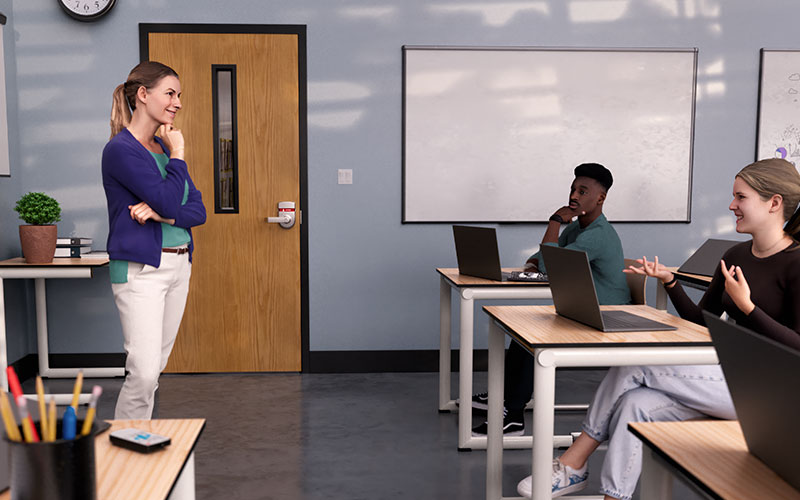While campus security and safety includes many aspects in and around the built environment, the door to a classroom or office has proven to be an essential line of defense against active shooters or other life safety threats. Locked and secured classrooms can provide effective shelter-in-place locations for faculty and students during a lockdown. As Jeff Koziol and Paul Timm note in a Campus Safety article, although protocols can vary between campuses, “a school lockdown generally includes locking the entrance to the room, turning off the lights, closing curtains and hiding or sheltering away from doors and windows.”
These steps can seem simple during low-stakes drills, but active shooter and other emergency situations can be chaotic and uncertain. On the one hand, this underscores the importance of having a set of protocols and procedures in place, which is similar to what Partner Alliance for Safer Schools (PASS) and other organizations have recommended for K-12 settings. It also emphasizes the importance of a locked and easily assessable door.
Campus security can start with a locked door
Locking hardware establishes a baseline of security in higher education. In fact, the Sandy Hook Advisory Commission states, “The testimony and other evidence presented to the Commission reveals that there has never been an event in which an active shooter breached a locked classroom door.” As such, it is important for security professionals, administrators and hardware specifiers to be aware of best practices around this crucial part of campus security and safety.
These best practices can include the functionality of a lock—its ability to lock from inside the room, support accessible, single-motion egress and allow first responders to enter if they have the key or credentials. These recommendations can also guide project stakeholders on important design considerations, including the use of locks with visual indication trims. This type of locking hardware can show whether the door is locked or unlocked, by using a light, color, symbol, word, or a combination of these. The idea is to be able to assess, at a glance, whether the door is locked without having to approach the door or turn the handle.

Further, locks with indication trim can save precious time by displaying the door’s locked or unlocked status to avoid confusion. Lock functions can vary in how they are engaged to secure the door. This can make locking less intuitive in settings where faculty do not have one set classroom. Likewise, in moments of high stress, this variability can cause uncertainty as to whether a door is locked or not. Visual indication of the door’s status can save time and offer peace of mind.
Locks with visual indication trims can also support occupants sheltering in place. While this strategy is effective at keeping occupants hidden from violent intruders, it makes checking a door’s status challenging. Indicator locks with large windows and 180-degree displays allow occupants to assess the locked status of a door from a distance and nearly every angle. This supports more secure classrooms and helps provide certainty that the locking hardware is engaged.
Indication trims offer peace of mind in emergency situations and everyday situations
Locking hardware with indication windows helps create peace of mind in chaotic situations like campus lockdowns. In fact, two teachers from Candace A. French Elementary School in Colorado note the benefit of locks with visual indication trims. This school was an early beta site for the new Schlage ND Indicator lock.

“The Schlage ND Indicator lock has come in handy during lockdown drills/hold drills as I am able to quickly be sure that my room is secured without having to open the door to double check,” says Karah P., a 4th grade teacher at the school.
Leigh G., a 5th grade teacher, agrees, saying, “Now, my students and I can quickly and easily make sure the door is locked just by looking at it.”
In addition to emergency preparedness, this type of lock also supports day-to-day functionality of school buildings. Indicator locks with windows that wrap front and sides can also help contribute to privacy in restrooms, testing areas, teachers’ lounges and other spaces within the built environment.
In this way, indicator locks contribute multiple points of value to educational settings—whether or not enhanced classroom security is a goal.
More from Author
Ken Cook, Allegion | Sep 3, 2024
Visual Indication Trims Solve Security Challenges in Retrofits
Backwards compatible visual indication trims can help retrofits more readily achieve recommendations for safer school design.
Ken Cook, Allegion | Apr 30, 2024
Using Locking Hardware to Support Code-Compliant Safer School Design
Code-compliant locking hardware is essential to safer school design. The right lock can support access control for improved school safety.








